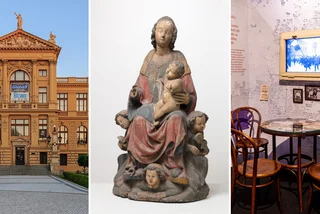Written by Natalie O’Hara
for Expats.cz
The first poetry written in what is now the Czech Republic dates back to the 9th century, when manuscripts containing hymns and devotional poems began to appear across Eastern Europe. This early Czech poetry was written in Old Church Slavic – a language developed by saints Methodius and Cyril as a way of fighting against Frankish (German) influence, although by the 11th century Latin had taken root. The first poems composed strictly in Czech, the Legends of King Wenceslas and Hospodine, pomiluj ny (Lord Have Mercy On Us), both date back to the 10th century. By the 13th and 14th centuries, Czech had become an accepted language for literature (kunstsprache), and scribes were composed in Czech at the courts of the Přemyslid kings. During this period, prose was rare in Europe, and even works such as scientific treatises, almanacs, and building manuals were generally written in verse. The Czech lands were no exception, and before prose began to take hold in around 1350 there was a great deal of Czech poetry written on every subject. Most popular were legends, epics, historical chronicles, theological tracts, biographies of saints (known as hagiography), and romances.
In the 15th century, the religious controversies sparked by reformer Jan Hus, and the Catholic Church´s weakening hold on Bohemia (in particular), led to a spate of religious satires and verse treatises (polemical poems) arguing one side of the religious debate. Early on, Bohemia showed signs of being influenced by the Italian Renaissance, not least due to the visit to Charles IV´s court by Petrarch, the poet, scholar and godfather of 14th-century humanism. The closest thing to a Renaissance poet writing in Czech in this period was King Jiři’s son Hynek z Poděbrad, who is credited with several texts including the poem A Dream of May, a semi-symbolic depiction of an erotic experience, and translations from the Italian poet Boccaccio.
A number of works appeared in the 16th century that were to shape the way Czech literature developed, including the writings of lexicographer Daniel Adam z Veleslavina, who extended and enriched the vocabulary of Czech, and the Unitas Fratrum scholars’ translation of the Bible into Czech (the Kralice Bible, completed in 1593). The language of this Bible would later become the model for classical and literary Czech. However, in 1620, native Czech literature was dealt a blow by the Battle of the White Mountain, in which the Austrian Habsburg army defeated the Bohemian Protestants. A new, non-Czech upper class was installed and the Czech language, now primarily used by the peasantry, came to be considered unsuitable for literature. However, the Czech émigrés who had fled the Habsburgs (most famously Jan Amos Komenský) kept Czech alive as a literary language, and within Bohemia and Moravia there was a blossoming of Catholic poetry in Latin, including works by the talented Classicist Bohuslav Balbín.
When the Romantic period dawned in the late 18th Century, Czechs were at the forefront. After two centuries of austere rule by foreign aristocrats, Romanticism´s celebration of nationalism, local tradition, and peasant culture appealed to Czech poets. The so-called National Revival began under the influence of writers like Josef Jungmann, whose translations into Czech and his monumental Czech-German dictionary were designed to prove the richness and adaptability of the Czech language. The Slovak poet Ján Kollár, who wrote in Czech, created the best of the early Romantic works, Slávy dcera – an allegorical sonnet sequence in which the narrator’s love for an idealized woman is transformed into patriotic love for his homeland. Another talented poet came in the surprising guise of a literary forger, Václav Hanka. Hanka counterfeited two manuscripts supposedly written in Medieval Czech, which are in themselves great pieces of Czech Romantic literature.
However, the greatest of the Czech Romantic poets was Karel Hynek Mácha. His most famous work, Máj (May), is made up of four songs and two intermezzos describing the doomed love of a bandit, Vilém, for Jarmila, a young woman who has been seduced by his father. The poem caused a scandal on publication, but has come to be seen as one of the most original and important works in Czech literature. Máj was particularly revolutionary because Mácha used iambic metre, a rhythm in which one unstressed syllable is followed by a stressed syllable in an alternating pattern – a startling innovation in Czech poetry. Mácha´s influence on later verse was so strong that the next generation of Czech writers were named the Máj Group in his honour. Poets belonging to this group included Vítězslav Hálek and the brilliant Jan Neruda, whose name was later borrowed by a fan of his work, the Chilean poet Pablo Neruda. In the late 19th Century, writers split into two opposing camps: in one were those involved with the journal Lumir (such as the masterly Jaroslav Vrchlický), who held that Czech literature needed to become more cosmopolitan and European; in the other those who sided with its competitor Ruch (such as the satirist Svatopluk Čech), and supported literature that followed native Czech traditions. At the end of the 19th century, new trends began to appear in the work of poets like Otokar Březina and Petr Bezruč. Březina in particular was a highly gifted poet whose subtle tone and skilful metrical structures (including free rhythms) had a strong influence on 20th-century Czech poetry.
After the establishment in 1918 of an independent Czechoslovak state, Czech literature thrived. While Čapek and Langer were revolutionising Czech drama and Hašek, Čapek, and Vančura were changing the face of the Czech novel, poetry did not lag behind. Between 1918 and 1945 poets like František Halas, Vítězslav Nezval, and Jaroslav Seifert (later awarded a Nobel prize for literature) were writing in a wide range of poetic genres to a high very standard. However, after the end of World War II the communist regime clamped down on free literary activity, and Czech literature underwent a steep decline. Drab social realism became the standard in both prose and poetry. Yet when political controls loosened in the 1960s, poetry underwent another temporary renaissance. Among this new generation were the poets Jiří Šotola, Miroslav Florian, Miroslav Holub and Karel Šiktanc, who aimed to create a new ‘poetry of the everyday’, and drew on the writings of Jacques Prevert and Italian Neorealist film. After the Warsaw Pact invasion in 1968, conditions again became harsh for writers. Many emigrated, others stayed and wrote for the underground samizdat press or had their manuscripts smuggled to the West.
Since the end of the communist era, poetry has undergone a leap, in quantitative terms at least. According to the literary critic Milan Jungmann, 180 new volumes of Czech poetry were published in the Czech Republic in the first half of 1996 alone. Although many critics complain that modern Czech poetry is overly experimental and abstract, there have been some success stories. The most influential poet of recent years has been the late Petr Kabeš, whose poetry attempted to incorporate elements from everyday language by drawing quotation, direct and reported speech into his texts. Among living writers, the young poet Petr Borkovec has become very popular with both readers and critics. Like many of the younger generation of Czech poets, Borkovec documents the turbulent changes undergone by the Czech Republic, viewing social developments through fine description of the details of everyday (often rural) life.












 Reading time: 6 minutes
Reading time: 6 minutes 





















